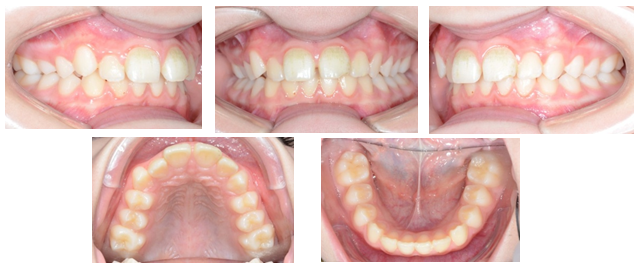Journal of
eISSN: 2373-4345


Case Report Volume 4 Issue 4
Al-Farabi College, Saudi Arabia
Correspondence: Ahmed Marghalani, Al-Farabi College, Al-Rahmanya Road, Jeddah 23642, Saudi Arabia
Received: December 24, 2015 | Published: May 10, 2016
Citation: Marghalani A. Treatment of class II division 1 with carriere distalizer. J Dent Health Oral Disord Ther. 2016;4(4):118-120. DOI: 10.15406/jdhodt.2016.04.00121
Non-extraction treatment of Class II malocclusion frequently requires upper molar distalization into a final Class I relationship. The creation and use of intermaxillary intraoral appliances for molar distalization in Class II malocclusion have been made possible through advancements in biomechanics and technology and materials that have allowed the delivery of light and constant forces over a wide range of deactivation.1 The carrier Distalizer is efficient and simple appliance for Class II treatment and achievement of Class I molar and canine relation in the beginning of the treatment.
Examination
An 11 years old female reported with chief complaint of space between upper and lower front teeth. Extra oral examination showed brachycephalic face type with convex profile. Nasolabial angle was normal and lips were competent (Figure 1). Intra oral examination showed Class II molar and canine relations, overjet 8 mm, overbite 4 mm and adequate space in both jaws (Figure 2).

Figure 2 Class II molar and canine relations, overjet 8 mm, overbite 4 mm and adequate space in both jaws.
Radiographic evaluation
Cephalometric analysis revealed skeletal Class II tendency and low angle; proclined and protruded upper incisors, proclined and retruded lower incisors (Figure 3). Panoramic radiograph showed full complement of dentition with 3rd molars in crown formation stage (Figure 4).
Diagnosis
Skeletally Class II tendency and low angle. Dentally Class II division 1
Treatment objective
To obtain good facial balance, reduce the overjet and achieve Class I molar and canine relationship.
Treatment plan
Molar distalization with Carriere Distalizer then fixed appliance.
Treatment progress
Carriere Distalizer was bonded in the upper jaw both sides. Buccal tubes were bonded on tooth #36 and #46 in the lower jaw with Essix retainer (buccal tubes areas were removed from the essix retainer). Class II elastics ¼ medium light were used. Carriere Distalizer was used for 5 months (Figure 5) until over distalization achieved to allow some relapse when changing to fixed appliance (Figure 6). Fixed appliance was used in both jaws for 1 year after removing the Carrier Distalizer then she was debonded (Figure 7).

Figure 5 Carriere Distalizer bonded with essix in the lower jaw and class II elastics ¼ medium light.
Treatment results
Molar and canine Class I relation was achieved. Overjet was reduced. Lower incisors were proclined. Patient’s profile was harmonious (Figure 8).
Carriere Distalizer is easy and convenience appliance to establish Class I molar relation in the beginning of the treatment, which can reduce treatment time in Class II non-extraction cases. The Distalizer is most effective in treating Class II malocclusions without extractions. Brachyfacial patterns respond best to treatment; dolichofacial types are less responsive. The appliance can also be used in many Class I cases with mesially positioned maxillary molars or, with caution, in Class I cases with premaxillary hypoplasia. Growing patients are ideal, but adults can be treated as well. Mixed dentition Class II cases with fully erupted first molars are candidates for first-phase treatment.Possible sources of anchorage are mandibular lingual arch, full mandibular fixed appliance, lower essix appliance (hooks for the elastics placed on the lower molar region), and miniscrews.2 Other distalizing appliances could have been used for molar distalization but would have required earlier bracket placement, mesial movement of the anterior teeth and anchorage loss.3 Carriere Distalizer is also more effective in achieving controlled derotation of the first molar. It rotates the maxillary first molar around its palatal root while producing bodily distal movement, before other appliances have been placed.2
It allows for straightforward Class II correction prior to orthodontics (fixed or clear aligners) at a time when no other mechanics interfere, and compliance is at its best.4 Carriere Distalizer appears to be more comfortable, offer a more positive overall experience, and has fewer negative side effects compared to the Forsus Fatigue Resistant Device.5
None.
The authors declare that there is no conflicts of interest.

©2016 Marghalani. This is an open access article distributed under the terms of the, which permits unrestricted use, distribution, and build upon your work non-commercially.